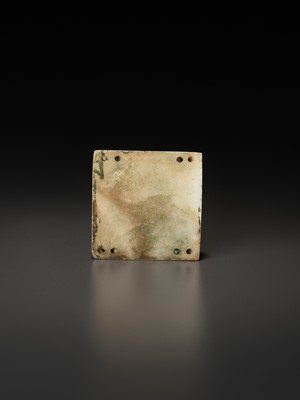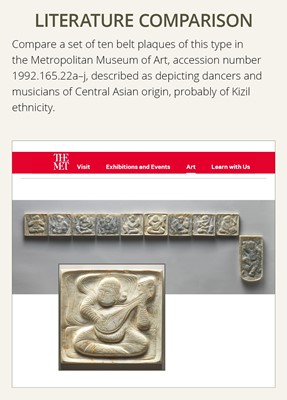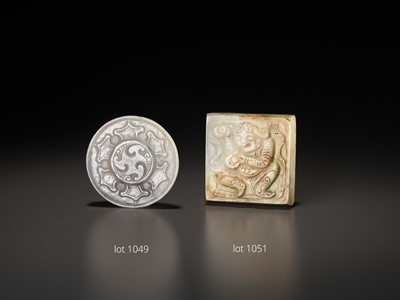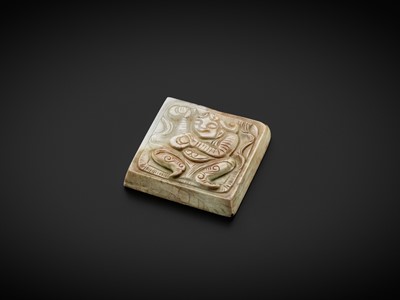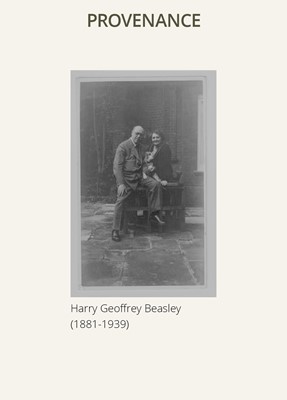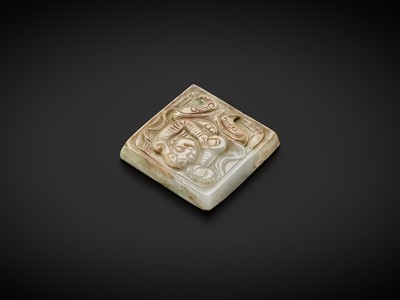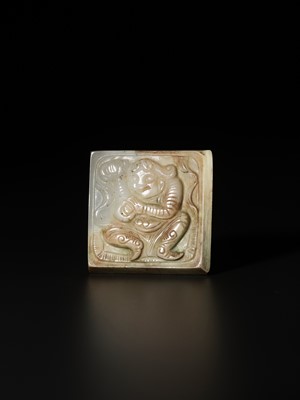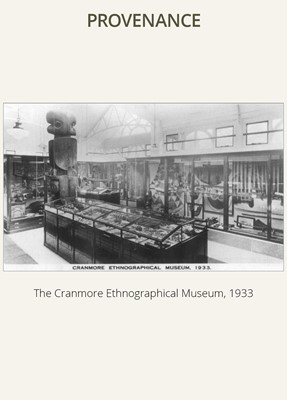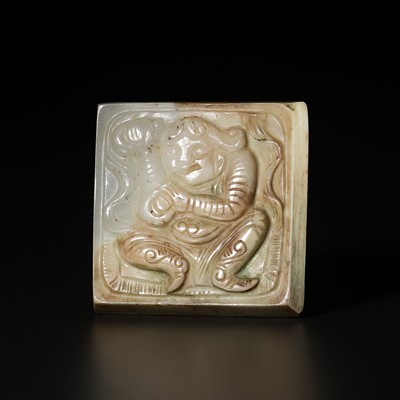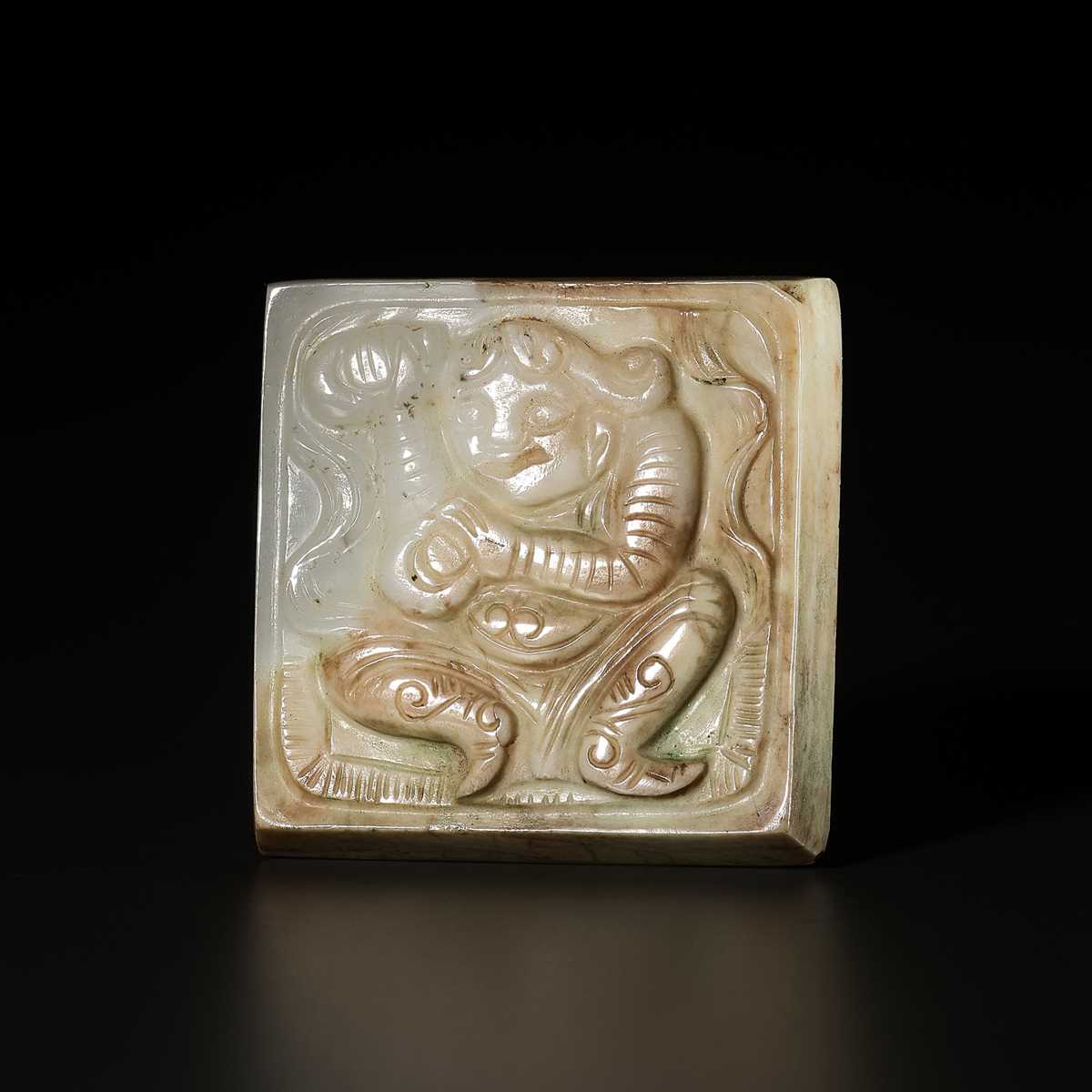1st Mar, 2024 10:00
The No Reserve Dragon Sale
82
A JADE ‘MUSICIAN’ BELT PLAQUE, TANG DYNASTY
唐代樂俑紋玉帶牌
Sold for €1,690
including Buyer's Premium
Please note this Lot is to be sold at No Reserve. 本拍品不設底價
China, 618-907. Of square form with slightly tapered sides, the top finely carved in relief with a musician of Central Asian origin seated on a mat and playing percussion instruments held in each hand. His robe neatly incised with folds, his boots with decorative designs, a scarf swirling around him. The back is pierced for attachment. The partly translucent stone of a white tone with extensive opaque calcification, showing a good surface polish and beautiful luster.
Provenance: Collection of Harry Geoffrey Beasley (1881-1939) and thence by descent to his widow Irene Beasley. Collection of Alfred William Cowperthwaite (1890-1964), acquired from the above c. 1939 and thence by descent in the same family. Harry Geoffrey Beasley (1881-1939) was a British anthropologist and museum curator who developed an important ethnographic collection during the early 20th century that is now held in various British museums. With his wife Irene, Beasley set up the Cranmore Ethnographical Museum which eventually held more than 6,000 objects of ethnographical interest. The Beasleys collected objects from across Europe, buying from auction houses and local museums to expand the collection, which contained material from the Pacific, Asia, Africa, and Northwestern America. Beasley wrote numerous articles for anthropological journals and was considered an expert in his field. He died in 1939 and his collection was stored with the British Museum collections during the war, which was fortunate as the Cranmore Museum was destroyed by bombing. After the war substantial portions of the collection were passed to the British Museum, the Royal Museum in Edinburgh, the Museum of Archaeology and Anthropology, the University of Cambridge, the Pitt Rivers Museum, and the Merseyside County Museum. Other pieces, such as the present lot, were sold by his widow and, after her death in 1974, by their daughters. Alfred William Cowperthwaite (1890-1964) was a contributor to the Cranmore Museum and became good friends with Harry Beasley. Shortly after Harry Beasley’s death, he acquired a number of objects from Irene Beasley, including the present lot.
Condition: Very good condition with expected old wear, tiny nicks and minuscule chips to edges which have smoothened over time. The pierced apertures with remnants of corrosion from ancient metal fittings. Some malachite and cuprite encrustations to the stone in these areas.
Weight: 30.5 g
Dimensions: Size 3.7 x 3.8 cm
Please click here to read the full description
Plaques such as the present example were produced from the early Tang dynasty in sets to adorn belts, with each plaque variously carved with musicians playing different instruments or as servers bearing tribute. Many of the figures are dressed in Central Asian style, in keeping with the fashion seen on foreigners in the Tang dynasty capital.
Literature comparison:
Compare two related jade belt plaques decorated with foreign figures playing musical instruments, illustrated in Jadeware (II) - The Complete Collection of Treasures of the Palace Museum, Hong Kong, 1995, pls. 22 and 23. Compare a set of ten belt plaques of this type in the Metropolitan Museum of Art, accession number 1992.165.22a–j, described as depicting dancers and musicians of Central Asian origin, probably of Kizil ethnicity.
Auction result comparison:
Type: Closely related
Auction: Bonhams London, 12 May 2022, lot 16
Price: GBP 63,300 or approx. EUR 81,500 converted and adjusted for inflation at the time of writing
Description: Two very pale green jade square belt plaques, Tang dynasty
Expert remark: Compare the closely related form and design. Note that this lot comprises two belt plaques. Note the smaller size (3.9 cm).
点此阅读中文翻译 (Chinese Translation)
唐代樂俑紋玉帶牌
中國,618-907年。呈方形,邊緣略呈錐形,頂部精美浮雕一位似乎來自中亞的樂俑坐在墊子上,雙手持打擊樂器。他的長袍上有整齊的衣紋,靴子上有裝飾圖案,一條圍巾環繞著他。背面穿孔用以連接。白色玉料部分呈半透明狀,大面積鈣化,表面拋光良好,光澤瑩潤。
來源:Harry Geoffrey Beasley (1881-1939)收藏,他逝世後由其遺孀Irene Beasley保存;Alfred William Cowperthwaite (1890-1964),約於1939年購於上述收藏,之後在同一家族保存至今。Harry Geoffrey Beasley (1881-1939) 是一位英國人類學家和博物館館長,他在二十世紀初建立了一個重要的民族志收藏,現在收藏在英國的各個博物館中。Beasley和他的妻子Irene一起建立了Cranmore民族志博物館,該博物館最終收藏了 6,000 多件民族志方面的物品。Beasley 收集了來自歐洲各地的物品,從拍賣行和當地博物館購買以擴大收藏範圍,其中包含來自太平洋、亞洲、非洲和美國西北部的資料。Beasley為人類學期刊撰寫了大量文章,被公認爲是該領域的專家。他於 1939 年去世,他的藏品幸虧在戰爭期間被存放在大英博物館裏,而Cranmore博物館被轟炸摧毀。戰後,大部分藏品被轉移到大英博物館、愛丁堡皇家博物館、劍橋大學考古與人類學博物館、Pitt Rivers博物館和Merseyside County博物館。其他收藏,例如現在的拍品,由他的遺孀出售,在她 1974 年去世後,由他們的女兒出售。Alfred William Cowperthwaite (1890-1964) 曾是Cranmore 民族志博物館重要支持人,也曾是 Harry Beasley的好友。在Harry Beasley去世不久,他從Irene Beasley 處購買了一些收藏,包括此件拍品。
品相:狀況極好,有磨損、微小的劃痕,邊緣有細微缺口,隨著時間的推移已經平滑。 帶有古代金屬配件穿孔,局部有綠色和紅褐色結殼。
重量:30.5 克
尺寸:3.7 x 3.8 厘米
像本例這樣的玉牌是唐初成套製作的,用來裝飾腰帶。每塊玉牌上都刻有演奏不同樂器的樂師,可能作為貢品。許多人物穿著中亞風格。
文獻比較:
比較兩件相關的玉帶牌,飾有正在演奏樂器的外國樂師,插圖見《玉器(二) - 故宮博物院館藏珍品全集》,香港,1995年,圖22 和 23。比較大都會藝術博物館的一組十塊此類腰帶牌,藏品編號 1992.165.22a-j,上面刻有中亞裔(可能是克孜爾族)的舞者和音樂家。
拍賣結果比較:
形制:非常相近
拍賣:倫敦邦瀚斯 ,2022年5月12日,lot 16
價格:GBP 63,300(相當於今日EUR 81,500)
描述:唐代青玉奏樂胡人紋帶板 一組兩件
專家評論:比較非常相近的外形和設計。請注意此玉牌為一對。請注意尺寸較小(3.9厘米)。
Please note this Lot is to be sold at No Reserve. 本拍品不設底價
China, 618-907. Of square form with slightly tapered sides, the top finely carved in relief with a musician of Central Asian origin seated on a mat and playing percussion instruments held in each hand. His robe neatly incised with folds, his boots with decorative designs, a scarf swirling around him. The back is pierced for attachment. The partly translucent stone of a white tone with extensive opaque calcification, showing a good surface polish and beautiful luster.
Provenance: Collection of Harry Geoffrey Beasley (1881-1939) and thence by descent to his widow Irene Beasley. Collection of Alfred William Cowperthwaite (1890-1964), acquired from the above c. 1939 and thence by descent in the same family. Harry Geoffrey Beasley (1881-1939) was a British anthropologist and museum curator who developed an important ethnographic collection during the early 20th century that is now held in various British museums. With his wife Irene, Beasley set up the Cranmore Ethnographical Museum which eventually held more than 6,000 objects of ethnographical interest. The Beasleys collected objects from across Europe, buying from auction houses and local museums to expand the collection, which contained material from the Pacific, Asia, Africa, and Northwestern America. Beasley wrote numerous articles for anthropological journals and was considered an expert in his field. He died in 1939 and his collection was stored with the British Museum collections during the war, which was fortunate as the Cranmore Museum was destroyed by bombing. After the war substantial portions of the collection were passed to the British Museum, the Royal Museum in Edinburgh, the Museum of Archaeology and Anthropology, the University of Cambridge, the Pitt Rivers Museum, and the Merseyside County Museum. Other pieces, such as the present lot, were sold by his widow and, after her death in 1974, by their daughters. Alfred William Cowperthwaite (1890-1964) was a contributor to the Cranmore Museum and became good friends with Harry Beasley. Shortly after Harry Beasley’s death, he acquired a number of objects from Irene Beasley, including the present lot.
Condition: Very good condition with expected old wear, tiny nicks and minuscule chips to edges which have smoothened over time. The pierced apertures with remnants of corrosion from ancient metal fittings. Some malachite and cuprite encrustations to the stone in these areas.
Weight: 30.5 g
Dimensions: Size 3.7 x 3.8 cm
Please click here to read the full description
Plaques such as the present example were produced from the early Tang dynasty in sets to adorn belts, with each plaque variously carved with musicians playing different instruments or as servers bearing tribute. Many of the figures are dressed in Central Asian style, in keeping with the fashion seen on foreigners in the Tang dynasty capital.
Literature comparison:
Compare two related jade belt plaques decorated with foreign figures playing musical instruments, illustrated in Jadeware (II) - The Complete Collection of Treasures of the Palace Museum, Hong Kong, 1995, pls. 22 and 23. Compare a set of ten belt plaques of this type in the Metropolitan Museum of Art, accession number 1992.165.22a–j, described as depicting dancers and musicians of Central Asian origin, probably of Kizil ethnicity.
Auction result comparison:
Type: Closely related
Auction: Bonhams London, 12 May 2022, lot 16
Price: GBP 63,300 or approx. EUR 81,500 converted and adjusted for inflation at the time of writing
Description: Two very pale green jade square belt plaques, Tang dynasty
Expert remark: Compare the closely related form and design. Note that this lot comprises two belt plaques. Note the smaller size (3.9 cm).
点此阅读中文翻译 (Chinese Translation)
唐代樂俑紋玉帶牌
中國,618-907年。呈方形,邊緣略呈錐形,頂部精美浮雕一位似乎來自中亞的樂俑坐在墊子上,雙手持打擊樂器。他的長袍上有整齊的衣紋,靴子上有裝飾圖案,一條圍巾環繞著他。背面穿孔用以連接。白色玉料部分呈半透明狀,大面積鈣化,表面拋光良好,光澤瑩潤。
來源:Harry Geoffrey Beasley (1881-1939)收藏,他逝世後由其遺孀Irene Beasley保存;Alfred William Cowperthwaite (1890-1964),約於1939年購於上述收藏,之後在同一家族保存至今。Harry Geoffrey Beasley (1881-1939) 是一位英國人類學家和博物館館長,他在二十世紀初建立了一個重要的民族志收藏,現在收藏在英國的各個博物館中。Beasley和他的妻子Irene一起建立了Cranmore民族志博物館,該博物館最終收藏了 6,000 多件民族志方面的物品。Beasley 收集了來自歐洲各地的物品,從拍賣行和當地博物館購買以擴大收藏範圍,其中包含來自太平洋、亞洲、非洲和美國西北部的資料。Beasley為人類學期刊撰寫了大量文章,被公認爲是該領域的專家。他於 1939 年去世,他的藏品幸虧在戰爭期間被存放在大英博物館裏,而Cranmore博物館被轟炸摧毀。戰後,大部分藏品被轉移到大英博物館、愛丁堡皇家博物館、劍橋大學考古與人類學博物館、Pitt Rivers博物館和Merseyside County博物館。其他收藏,例如現在的拍品,由他的遺孀出售,在她 1974 年去世後,由他們的女兒出售。Alfred William Cowperthwaite (1890-1964) 曾是Cranmore 民族志博物館重要支持人,也曾是 Harry Beasley的好友。在Harry Beasley去世不久,他從Irene Beasley 處購買了一些收藏,包括此件拍品。
品相:狀況極好,有磨損、微小的劃痕,邊緣有細微缺口,隨著時間的推移已經平滑。 帶有古代金屬配件穿孔,局部有綠色和紅褐色結殼。
重量:30.5 克
尺寸:3.7 x 3.8 厘米
像本例這樣的玉牌是唐初成套製作的,用來裝飾腰帶。每塊玉牌上都刻有演奏不同樂器的樂師,可能作為貢品。許多人物穿著中亞風格。
文獻比較:
比較兩件相關的玉帶牌,飾有正在演奏樂器的外國樂師,插圖見《玉器(二) - 故宮博物院館藏珍品全集》,香港,1995年,圖22 和 23。比較大都會藝術博物館的一組十塊此類腰帶牌,藏品編號 1992.165.22a-j,上面刻有中亞裔(可能是克孜爾族)的舞者和音樂家。
拍賣結果比較:
形制:非常相近
拍賣:倫敦邦瀚斯 ,2022年5月12日,lot 16
價格:GBP 63,300(相當於今日EUR 81,500)
描述:唐代青玉奏樂胡人紋帶板 一組兩件
專家評論:比較非常相近的外形和設計。請注意此玉牌為一對。請注意尺寸較小(3.9厘米)。
Zacke Live Online Bidding
Our online bidding platform makes it easier than ever to bid in our auctions! When you bid through our website, you can take advantage of our premium buyer's terms without incurring any additional online bidding surcharges.
To bid live online, you'll need to create an online account. Once your account is created and your identity is verified, you can register to bid in an auction up to 12 hours before the auction begins.
Intended Spend and Bid Limits
When you register to bid in an online auction, you will need to share your intended maximum spending budget for the auction. We will then review your intended spend and set a bid limit for you. Once you have pre-registered for a live online auction, you can see your intended spend and bid limit by going to 'Account Settings' and clicking on 'Live Bidding Registrations'.
Your bid limit will be the maximum amount you can bid during the auction. Your bid limit is for the hammer price and is not affected by the buyer’s premium and VAT. For example, if you have a bid limit of €1,000 and place two winning bids for €300 and €200, then you will only be able to bid €500 for the rest of the auction. If you try to place a bid that is higher than €500, you will not be able to do so.
Online Absentee and Telephone Bids
You can now leave absentee and telephone bids on our website!
Absentee Bidding
Once you've created an account and your identity is verified, you can leave your absentee bid directly on the lot page. We will contact you when your bids have been confirmed.
Telephone Bidding
Once you've created an account and your identity is verified, you can leave telephone bids online. We will contact you when your bids have been confirmed.
Classic Absentee and Telephone Bidding Form
You can still submit absentee and telephone bids by email or fax if you prefer. Simply fill out the Absentee Bidding/Telephone bidding form and return it to us by email at office@zacke.at or by fax at +43 (1) 532 04 52 20. You can download the PDF from our Upcoming Auctions page.
How-To Guides
How to Create Your Personal Zacke Account
How to Register to Bid on Zacke Live
How to Leave Absentee Bids Online
How to Leave Telephone Bids Online
中文版本的操作指南
创建新账号
注册Zacke Live在线直播竞拍(免平台费)
缺席投标和电话投标
Third-Party Bidding
We partner with best-in-class third-party partners to make it easy for you to bid online in the channel of your choice. Please note that if you bid with one of our third-party online partners, then there will be a live bidding surcharge on top of your final purchase price. You can find all of our fees here. Here's a full list of our third-party partners:
- 51 Bid Live
- EpaiLive
- ArtFoxLive
- Invaluable
- LiveAuctioneers
- the-saleroom
- lot-tissimo
- Drouot
Please note that we place different auctions on different platforms. For example, in general, we only place Chinese art auctions on 51 Bid Live.
Bidding in Person
You must register to bid in person and will be assigned a paddle at the auction. Please contact us at office@zacke.at or +43 (1) 532 04 52 for the latest local health and safety guidelines.

